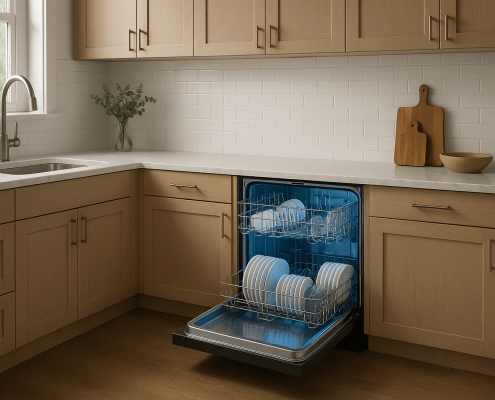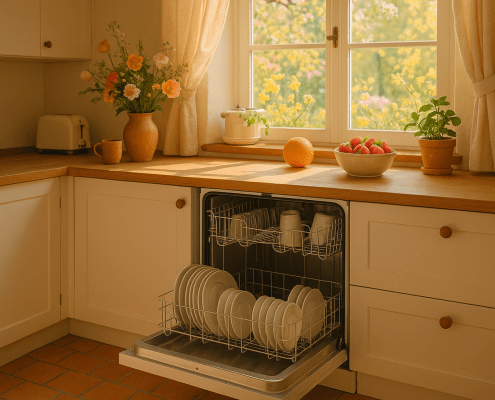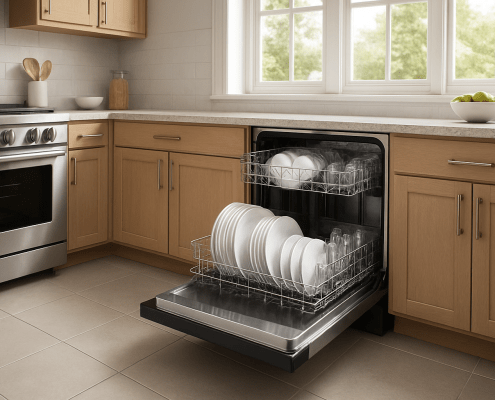How to replace the turbidity sensor on a Bosch dishwasher
Steven E / Wednesday April 30, 2025
Struggling with lackluster dishwashing results from your Bosch dishwasher? A faulty turbidity sensor might be to blame, leading to improper cleaning cycles. Don’t fret—our step-by-step guide, complete with a how-to video below, will show you how to replace it easily on your own.
Looking for the right part? Enter your appliance model number below to find the exact match and get your appliance running like new again!
The turbidity sensor on a Bosch dishwasher measures the cloudiness or turbidity of the water inside the dishwasher. This allows the control board to determine the appropriate length and intensity of the cleaning cycle. Over time, the turbidity sensor can become faulty or damaged, leading to inaccurate readings and poor cleaning. Fortunately, replacing the turbidity sensor is a fairly easy and quick repair process that you can do yourself.
Watch here: How To: Bosch/Thermador/Gaggenau Turbidity Sensor 00165279
The information in this article may not apply to your specific appliance model. We recommend consulting your manufacturer’s documentation or contact us with any questions.
Tools needed
- 5/8″ wrench
- 5/16″ nut driver
- Torx 20 screwdriver
- Phillips screwdriver
- Flathead screwdriver
- Towel
Safety precautions
- Always power off and unplug your appliance or switch off the circuit breaker before attempting any maintenance or replacement work. This keeps you safe by preventing any risk of injury from electric shock.
- Turn off the water supply at the outlet before beginning repairs to any appliance parts that hold water. Have towels ready for any residual water in the system when removing parts.
- Wear insulated work gloves to protect your hands from sharp metal parts, pinching hazards and debris.
- Don’t test wiring with a multimeter for live voltage if you’re unfamiliar with how to prevent short circuiting when testing.
- When working with wires, avoid touching any exposed wires or terminals. If you need to touch a wire, use a non-conductive tool or wear insulating gloves to prevent electrical shock.
- Take your time and don’t rush while working to prevent accidents and personal injuries.
- Work in a well-lit area so you can clearly see and access the interior parts.
- Clear your workspace of clutter and other obstacles. Keep children and pets away from the work area.
- Never work on internal parts with bare wet hands. Make sure the work area is completely dry.
- Check your user manual to see if there are specific installation or safety instructions for your part or appliance.
- Be gentle when handling or removing parts. Excessive force might damage the appliance or cause injury.
- Wear safety glasses when working with chemicals, dust or cleaning large debris to prevent injury.
- If the appliance has recently been used, give it plenty of time for any heating parts to cool down before working on it.
Replacement steps
Disassembly
- Under the sink, locate the fill line connected to the hot water valve. Turn the water supply off.
- Place a towel down to catch any water that may come out when disconnecting the lines.
- Use a 5/8 inch wrench to loosen the hose and disconnect the fill line.
- Remove the drain hose by locating its end which may be connected to the garbage disposal or air gap and using a 5/16 nut-driver to loosen the clamp. Pull the hose off.
- Open the dishwasher door and remove the lower rack by pulling it out, lifting it off, and setting it aside.
- Take out the spray arm by lifting it up and setting it aside.
- Remove the filter basket by turning the arrow to three o’clock and lifting it out.
- Lift the front of the fine filter and pull it out.
- Use a Torx 20 driver to remove the four screws that hold the sump to the body.
- Use a Philips screwdriver to remove all the screws that hold the dishwasher mounting brackets to the countertop or cabinet.
- Remove the screws that hold the front panel onto the door using a Torx 20 driver. Remove only the three screws on each side.
- Close the dishwasher door and pull the panel off. Set the panel and spacers aside. Pull the dishwasher out.
- Remove the side panels by using a Torx 20 driver to take out the screws. Pull the panels forward to release the tabs at the back, drop them down, and pull them off.
- From the back, remove the two lower screws that hold the tub to the base using a Torx 20 driver.
- Place a towel down to protect the floor. Carefully lay the dishwasher on its back.
- Use a Philips screwdriver to remove the screws that hold the kick panel. Lift the kick panel up and set it aside.
- Use a Torx 20 driver to remove the two screws that hold the support panel on, one on each end. Lift the support panel off and set it aside.
- Disconnect the hinges on each side. Remove the covers and unhook the cables by pulling up on them and unhooking them from the hinge. Do this for both sides.
- Remove the hose between the sump and the inlet by unplugging it from the sump and unclipping it.
- Remove the drain pump by lifting up on the locking tab and turning the pump clockwise to release it from the sump. Set it down in the bottom of the dishwasher.
- On the right-hand side, remove the straps that hold the motor to the bottom of the dishwasher using a flat-head screwdriver. Assist with removing them.
- Use a Torx 20 driver to remove the screw on each side that holds the base to the frame.
- Pull the base down just enough to remove the sump assembly. Lift the sump assembly out, disconnecting the hose plugged into the sump. Carefully lift the sump assembly off and set it on the door.
- Remove the wiring harness from the turbidity sensor by pulling on it. Lift up on the locking tabs on the top and bottom of the sensor and use a flathead screwdriver to push on them. Pull out the sensor.
Installation
- Take the o-ring off the old sensor. Wet the o-ring and the sump opening to make it easier to slide the new sensor in. Press it in and lock it in place.
- Connect the wiring harness by pushing it on. Lift the sump assembly and lower it into place.
- Grab the hose and plug it into the sump, ensuring it goes into the holder at the bottom.
- Lift the base up onto the bottom of the tub Make sure the base goes into the grommet on the bottom of the sump.
- Once the base is pushed all the way up, use the Torx 20 driver to secure the screws that hold the base to the frame.
- Put the mounting straps back on to hold the motor, stretching them over the mounting posts with a flathead screwdriver.
- Put the shield back on by sliding it into place.
- Put the drain pump and hose back in, ensuring the o-ring is wet if needed. Put the pump in with the locking tab at the 12 o’clock position and turn it counterclockwise to lock it in. Insert the hose under the holder and plug it into the sump.
- Hook up the hinge cables by stretching them out and hooking them onto the hinge. Put the hinge covers onand secure them.
- Lift the dishwasher up and place it back into the cabinet opening.
- Reinstall the kick panel by lining it up and screwing it in with the Philips screwdriver.
- Stand the dishwasher upright and reinstall the side panels by lining them up and pushing them into place. Secure them with the Torx 20 screws.
- Slide the dishwasher back into place.
- Reinstall the front panel by lifting it up, hooking it onto the top tabs, and pushing it up into place. Secure it with the Torx 20 screws on each side.
- Reattach the screws that hold the dishwasher to the countertop using the Philips screwdriver.
- Reinstall the sump screws by aligning the holes and tightening them with the Torx 20 driver.
- Reinstall the fine filter by sliding it into place and rotating the arrow to six o’clock.
- Place the filter basket back in by aligning the tabs and turning the arrow to 12 o’clock.
- Reinstall the spray arm by lining it up and pressing it down until it clicks into place.
- Slide the lower rack back into the dishwasher.
- Reconnect the drain hose by sliding it onto the drain port and tightening the clamp with the 5/16 nut-driver.
- Reconnect the fill line by sliding it onto the hot water valve and tightening the hose with the 5/8 inch wrench.
- Turn on the hot water valve under the sink. Close the dishwasher door and run a test cycle to verify that the new turbidity sensor is working properly.
Additional information
Thanks for reading! We hope this guide helped you replace the turbidity sensor on your Bosch dishwasher.
If you still need some replacement parts, grab your model number and head over to AppliancePartsPros.com. We offer over two million parts and most orders arrive in two business days. If you need some help with finding the right part or placing an order, you can contact our team at 1 (877) 477-7278.
While you’re waiting for your new part to arrive, you can explore our DIY blog and watch thousands of video tutorials on our YouTube channel.
Be sure to follow us on Facebook, Twitter and Instagram to see our latest repair guides!
With nearly a decade of experience in providing top-notch customer service regarding appliance parts and repair, Steven enjoys sharing practical advice, troubleshooting tips, and interesting information to help readers stay informed.





